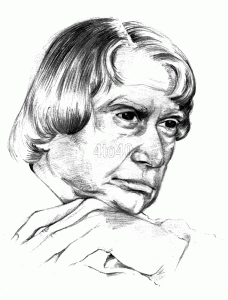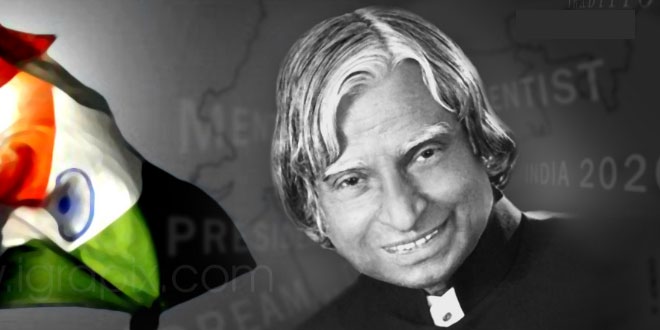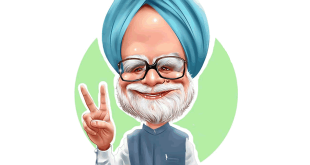A. P. J. Abdul Kalam – Avul Pakir Jainulabdeen Abdul Kalam (born 15 October, 1931 – died 27 July, 2015) is an Indian scientist and administrator who served as the 11th President of India from 2002 to 2007. Kalam was born and raised in Rameswaram, Tamil Nadu, studied physics at the St. Joseph’s College, Tiruchirappalli, and aerospace engineering at the Madras Institute of Technology, Chennai.
A. P. J. Abdul Kalam Biography
| Name: | Avul Pakir Jainulabdeen Abdul Kalam (A. P. J. Abdul Kalam) |
| Born: | 15 October, 1931 Rameswaram, Madras Presidency, British India |
| Died: | 27 July, 2015 (aged 83) Shillong, Meghalaya, India |
| Resting place: | Dr. A.P.J. Abdul Kalam Memorial, Rameswaram, Tamil Nadu, India |
| Alma mater: | St. Joseph’s College, Tiruchirappalli (B.Eng) Madras Institute of Technology (MEng) |
| Profession: | Statesman, Aerospace Scientist, Author |
| Notable work(s): | Wings of Fire, India 2020, Ignited Minds, Indomitable Spirit, Transcendence: My Spiritual Experiences with Pramukh Swamiji |
| Awards: | Padma Bhushan, Padma Vibhushan, Bharat Ratna (1997) |
Before his term as President, he worked as an Aerospace engineer with Defence Research and Development Organisation (DRDO) and Indian Space Research Organisation (ISRO). Kalam is popularly known as the Missile Man of India for his work on the development of ballistic missile and launch vehicle technology. He played a pivotal organisational, technical and political role in India’s Pokhran-II nuclear tests in 1998, the first since the original nuclear test by India in 1974.
 Kalam was elected the President of India in 2002, defeating Lakshmi Sahgal, was nominated by Bharatiya Janata Party and supported by opposition Indian National Congress, the major political parties of India. He is currently a visiting professor at Indian Institute of Management Shillong, Indian Institute of Management Ahmedabad and Indian Institute of Management Indore, honorary fellow of Indian Institute of Science, Bangalore, Chancellor of the Indian Institute of Space Science and Technology Thiruvananthapuram, a professor of Aerospace Engineering at Anna University (Chennai), JSS University (Mysuru) and an adjunct/visiting faculty at many other academic and research institutions across India.
Kalam was elected the President of India in 2002, defeating Lakshmi Sahgal, was nominated by Bharatiya Janata Party and supported by opposition Indian National Congress, the major political parties of India. He is currently a visiting professor at Indian Institute of Management Shillong, Indian Institute of Management Ahmedabad and Indian Institute of Management Indore, honorary fellow of Indian Institute of Science, Bangalore, Chancellor of the Indian Institute of Space Science and Technology Thiruvananthapuram, a professor of Aerospace Engineering at Anna University (Chennai), JSS University (Mysuru) and an adjunct/visiting faculty at many other academic and research institutions across India.
Kalam advocated plans to develop India into a developed nation by 2020 in his book India 2020. He has received several prestigious awards, including the Bharat Ratna, India’s highest civilian honour. Kalam is known for his motivational speeches and interaction with the student community in India. He launched his mission for the youth of the nation in 2011 called the What Can I Give Movement with a central theme to defeat corruption in India.
Early Life and Education:
Avul Pakir Jainulabdeen Abdul Kalam was born on 15 October 1931 in a Tamil Muslim family to Jainulabudeen, a boat owner and Ashiamma, a housewife, at Rameswaram, Ramanathapuram District, located in the Indian state of Tamil Nadu. He came from a poor background and started working at an early age to supplement his family’s income. After completing school, Kalam distributed newspapers to financially contribute to his father’s income. In his school years, he had average grades, but was described as a bright and hardworking student who had a strong desire to learn and spend hours on his studies, especially mathematics. He was just a simple man with a great fierceful heart in his childhood. After completing his school education at the Ramanathapuram Schwartz Matriculation School, Kalam went on to attend Saint Joseph’s College, Tiruchirappalli, then affiliated with the University of Madras, from where he graduated in physics in 1954. Towards the end of the course, he was not enthusiastic about the subject and would later regret the four years he studied it. He then moved to Madras in 1955 to study aerospace engineering. While Kalam was working on a senior class project, the Dean was dissatisfied with the lack of progress and threatened revoking his scholarship unless the project was finished within the next three days. He worked tirelessly on his project and met the deadline, impressing the Dean who later said, “I [Dean] was putting you [Kalam] under stress and asking you to meet a difficult deadline”. He narrowly missed achieving his dream of becoming a fighter pilot, as he placed ninth in qualifiers, and only eight positions were available in the IAF.
A. P. J. Abdul Kalam: Career as a scientist
After graduating from the Madras Institute of Technology in 1960, Kalam joined the Aeronautical Development Establishment of the Defence Research and Development Organisation (by Press Information Bureau, Government of India) as a scientist after becoming a member of the Defence Research & Development Service (DRDS). He started his career by designing a small hovercraft, but remained unconvinced by his choice of a job at DRDO.Kalam was also part of the INCOSPAR committee working under Vikram Sarabhai, the renowned space scientist.In 1969, Kalam was transferred to the Indian Space Research Organisation (ISRO) where he was the project director of India’s first Satellite Launch Vehicle (SLV-III) which successfully deployed the Rohini satellite in near-earth orbit in July 1980; Kalam had first started work on an expandable rocket project independently at DRDO in 1965.In 1969, Kalam received the government’s approval and expanded the programme to include more engineers.
In 1963 to 1964, he visited NASA’s Langley Research Center in Hampton, Virginia; Goddard Space Flight Center in Greenbelt, Maryland; and Wallops Flight Facility.Between the 1970s and 1990s, Kalam made an effort to develop the Polar Satellite Launch Vehicle (PSLV) and SLV-III projects, both of which proved to be successful.
Kalam was invited by Raja Ramanna to witness the country’s first nuclear test Smiling Buddha as the representative of TBRL, even though he had not participated in its development. In the 1970s, Kalam also directed two projects, Project Devil and Project Valiant, which sought to develop ballistic missiles from the technology of the successful SLV programme. Despite the disapproval of the Union Cabinet, Prime Minister Indira Gandhi allotted secret funds for these aerospace projects through her discretionary powers under Kalam’s directorship. Kalam played an integral role convincing the Union Cabinet to conceal the true nature of these classified aerospace projects.His research and educational leadership brought him great laurels and prestige in the 1980s, which prompted the government to initiate an advanced missile programme under his directorship. Kalam and Dr V S Arunachalam, metallurgist and scientific adviser to the Defence Minister, worked on the suggestion by the then Defence Minister, R. Venkataraman on a proposal for simultaneous development of a quiver of missiles instead of taking planned missiles one after another. R Venkatraman was instrumental in getting the cabinet approval for allocating ₹ 3.88 billion for the mission, named Integrated Guided Missile Development Programme (IGMDP) and appointed Kalam as the chief executive. Kalam played a major part in developing many missiles under the mission including Agni, an intermediate range ballistic missile and Prithvi, the tactical surface-to-surface missile, although the projects have been criticized for mismanagement and cost and time overruns.
A. P. J. Abdul Kalam served as the Chief Scientific Adviser to the Prime Minister and Secretary of the Defence Research and Development Organisation from July 1992 to December 1999. The Pokhran-II nuclear tests were conducted during this period in which he played an intensive political and technological role. Kalam served as the Chief Project Coordinator, along with Rajagopala Chidambaram, during the testing phase. Media coverage of Kalam during this period made him the country’s best known nuclear scientist.
In 1998, along with cardiologist Soma Raju, Kalam developed a low cost coronary stent, named the “Kalam-Raju Stent”. In 2012, the duo designed a rugged tablet computer for health care in rural areas, which was named the “Kalam-Raju Tablet”.
Presidency:
Kalam served as the 11th President of India, succeeding K. R. Narayanan. He won the 2002 presidential election with an electoral vote of 922,884, surpassing the 107,366 votes won by Lakshmi Sahgal. His term lasted from 25 July 2002 to 25 July 2007. During his term as president, he was affectionately known as the People’s President.
Death:
On 27 July 2015, Kalam travelled to Shillong to deliver a lecture on “Creating a Livable Planet Earth” at the Indian Institute of Management Shillong. While climbing a flight of stairs, he experienced some discomfort, but was able to enter the auditorium after a brief rest. At around 6:35 p.m. IST, only five minutes into his lecture, he collapsed. He was rushed to the nearby Bethany Hospital in a critical condition; upon arrival, he lacked a pulse or any other signs of life. Despite being placed in the intensive care unit, Kalam was confirmed dead of a sudden cardiac arrest at 7:45 p.m IST.
 Kids Portal For Parents India Kids Network
Kids Portal For Parents India Kids Network








4 comments
Pingback: Hindi Poem in memory of Dr. Abdul Kalam कलाम का कमाल: एक श्रदधांजलि - Kids Portal For Parents
Pingback: APJ Abdul Kalam Images: APJ Abdul Kalam Stock Photos - Kids Portal For Parents
Pingback: Rakhi Day is Righteous Day: APJ Abdul Kalam Poetry on Rakhi - Kids Portal For Parents
Pingback: Enlightening Story by Dr. APJ Abdul Kalam: Burnt Roti - Kids Portal For Parents